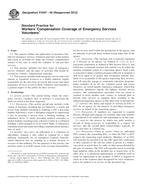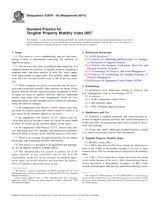Potřebujeme váš souhlas k využití jednotlivých dat, aby se vám mimo jiné mohly ukazovat informace týkající se vašich zájmů. Souhlas udělíte kliknutím na tlačítko „OK“.
ASTM F2047-00(2012)
Standard Practice for Workers’ Compensation Coverage of Emergency Services Volunteers
Automaticky přeložený název:
Standardní praxe pro pracovníky & rsquo; Kompenzace Pokrytí záchranných služeb dobrovolníků
NORMA vydána dne 1.5.2012
Informace o normě:
Označení normy: ASTM F2047-00(2012)
Poznámka: NEPLATNÁ
Datum vydání normy: 1.5.2012
Kód zboží: NS-52577
Počet stran: 5
Přibližná hmotnost: 15 g (0.03 liber)
Země: Americká technická norma
Kategorie: Technické normy ASTM
Kategorie - podobné normy:
Anotace textu normy ASTM F2047-00(2012) :
Keywords:
emergency services worker, emergency services volunteer, workers&rsquo, compensation insurance, Community education, Emergency services volunteers, GPEV (general public emergency volunteer), AU (auxilliary unit), PSAR (preventive search and rescue), Volunteers, Workers compensation coverage, ICS Number Code 03.060 (Finances. Banking. Monetary systems. Insurance)
Doplňující informace
| Significance and Use |
|
It is presumed for the purposes of this practice that the legal authority (agency) having responsibility for emergency services in a given jurisdiction also has a legal responsibility to provide workers’ compensation Insurance coverage for regular paid employees. Emergency services volunteers are presumed to be requested irregularly to provide special skills or assistance on behalf of the agency. As such, these volunteers act as part-time employees of the agency and are empowered to act to provide these services when specifically requested to do so, or pursuant to an approved plan or schedule, or under the supervision of a full-time employee. The legal authority incurs workers’ compensation insurance responsibility for emergency services volunteers (ESVs) while the ESV is actively providing services to the agency as defined in Section 5 of this practice. This period of activity shall be considered to be employment as defined by the state workers’ compensation statutes of the agency. When a legal authority (agency) requests the services of emergency services volunteers as defined by this practice to provide services, the agency shall assume responsibility for the injuries, medical treatment, loss of wages, and death of those emergency services volunteers while providing services as described in this practice. Responsibility for the injuries, medical treatment, loss of wages, and death of those emergency services volunteers while providing services as described in this practice shall be at the statutory limits of the workers’ compensation laws of the state of the agency requesting the services of the emergency services volunteer, and shall be administered in accordance with that agency's state workers’ compensation laws and regulations. Responsibility for workers’ compensation for members of emergency services units shall be the same as outlined in 3.1, and shall be provided by the agency normally directing the activities of the ESU. Responsibility for workers’ compensation for members of emergency services auxiliary units shall be the same as outlined in 3.1, and, unless provided for by other statute or agreement, shall be provided by the agency requesting the services and directing the activities of the AU. To provide an agency with trained personnel who are able to work in a safe and effective manner, it is generally required that the emergency service volunteer engage in training activity with the emergency service unit. A training plan is considered essential in establishing the basis for workers’ compensation insurance coverage during training. The plan serves as both prior notice to the responsible legal authority and documentation of training done to support the level of service provided. The training plan is considered to be a dynamic document, reflecting necessary changes due to weather, unit participation, newly identified skills, and rearranged priorities. As changes are made to the training plan, the revised plan is to be submitted to the agency. The training plan may be required by the agency, municipality, or government entity providing coverage and benefits in accordance with its contract for services or merely as a convenience to define activity periods. The training plan should establish goals and list measurable objectives. These goals provide a basis for a relationship between training and the incident response services provided. The plan should list all planned activity of the unit and who is expected to participate. This will delineate where insurance coverage is needed and expected. The plan should detail what supervision of activities and resources of the legal authority is expected. The plan should establish a means of accountability to the responsible legal authority for the unit's training activities, such as by check-in with a central dispatch, and listing on a formal activity roster. The training plan will contain the following elements to qualify for inclusion in workers’ compensation coverage: Identification of the emergency services unit. Definition of the period of time covered by the plan, usually a year. Establishment of the relationship of the ESU with the legal authority. Establishment of the overall plan goals. Broad outline of training plan (that is, field and classroom, equipment maintenance, training outside of the jurisdiction of the agency, and so forth). Specific outline of training plan (such as rappelling, nighttime field navigation, search and fire fighting techniques, medical applications, and so forth). Establishment of criteria for objective satisfaction. This training plan and activity must address techniques, skills and safety, and must be designed to enable the individual and the unit to meet recognized national standards or other standards as acceptable to the requesting agency. It is recognized that training for hazardous activity is often hazardous in and of itself, by the nature of the skills that the ESV is required to master. Since the agency is the beneficiary of this training, the ESV is said to be employed by the agency for the purposes of workers’ compensation benefits while engaging in training as a member of an emergency services unit. Covered training activities are those activities defined as official activities in a memorandum of understanding or other agreement between the ESU and the agency, where the agency is providing workers’ compensation benefits. An emergency services volunteer or unit may be requested by an agency to provide public education services. These services may include public appearances, preventative search and rescue (PSAR) programs, air search familiarization for ground search operations, first aid and CPR education, fire prevention education, and others. When engaged in such activities authorized by the agency, the ESV or ESU is considered to be employed by the agency for the purposes of workers’ compensation insurance. |
| 1. Scope |
|
1.1 This practice defines the application of insurance benefits for emergency services volunteers and units in the manner and extent as provided for under the workers’ compensation statutes of the state in which the volunteer or unit provides services. 1.2 This practice identifies the basic types of emergency service volunteer, and the types of activities that should be covered by workers’ compensation insurance. 1.3 This practice includes both emergency service units who operate as organized resources to a public authority legally responsible for the provision of search and rescue and other emergency services, as well as those volunteers who respond to a general request to the public for their services. |
Podobné normy:
Historická
1.5.2007
Historická
1.11.2013
Historická
1.6.2014
Historická
1.6.2014
Historická
15.3.2010
Historická
1.2.2006
Doporučujeme:
Aktualizace technických norem
Chcete mít jistotu, že používáte pouze platné technické normy?
Nabízíme Vám řešení, které Vám zajistí měsíční přehled o aktuálnosti norem, které používáte.
Chcete vědět více informací? Podívejte se na tuto stránku.



 ASTM E2557-07
ASTM E2557-07 ASTM E2606-13
ASTM E2606-13 ASTM E2675-09(2014)..
ASTM E2675-09(2014).. ASTM E2676-09(2014)..
ASTM E2676-09(2014).. ASTM E2718-10
ASTM E2718-10 ASTM F1090-06
ASTM F1090-06
 Cookies
Cookies
